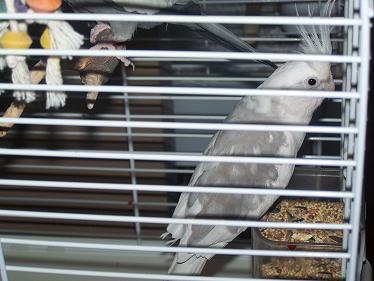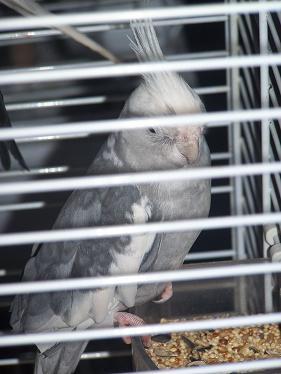Here are my 2 new tiels. I *think* I have a male and a female.


I would really like to eventually have one clutch of babies(assuming I have a male and female). I currently have 4 teils. 2 are definate males(I have a lutino male and a grey male) I think out of the 2 pictured the one with the solid whiteface is a male and the one with the grey face is a female.
I am currently researching breeding, but thought I'd throw out a few questions to the knowledgable BYCers.
The boys range in age from 2years to 4 years. The female is 3 years old(if she is indeed a female). SO all at good breeding age. All are healthy.
How would I go about pairing them up? Just pick the 2 I'd like to be a pair and cage them seperately with a nesting box? Or do I allow her to pick her mate? If so, would I just cage them all together and see who she bonds with and then switch them to a breeding cage?(with longer day light, soft foods, frequent baths...the works).
Also can anybody tell me the color/mutations of my 2 new fellows? I know they are both white faces and are both pied. But was told the "male" may be a cinnamon or a silver... I'd like to know in actuality what his color is called.
These 2 have been caged together(along with another male grey, until recently). Have never laid an egg and have never been seen breeding. I'm not sure if that rules out the possibility of one being a female. Or if not having a nest box and also having a third tiel in the cage would have stopped "her" from ever laying.
Any advice is very much appreciated, also stories or others experiences breeding tiels would be helpful.
Thanks in advance.


I would really like to eventually have one clutch of babies(assuming I have a male and female). I currently have 4 teils. 2 are definate males(I have a lutino male and a grey male) I think out of the 2 pictured the one with the solid whiteface is a male and the one with the grey face is a female.
I am currently researching breeding, but thought I'd throw out a few questions to the knowledgable BYCers.
The boys range in age from 2years to 4 years. The female is 3 years old(if she is indeed a female). SO all at good breeding age. All are healthy.
How would I go about pairing them up? Just pick the 2 I'd like to be a pair and cage them seperately with a nesting box? Or do I allow her to pick her mate? If so, would I just cage them all together and see who she bonds with and then switch them to a breeding cage?(with longer day light, soft foods, frequent baths...the works).
Also can anybody tell me the color/mutations of my 2 new fellows? I know they are both white faces and are both pied. But was told the "male" may be a cinnamon or a silver... I'd like to know in actuality what his color is called.
These 2 have been caged together(along with another male grey, until recently). Have never laid an egg and have never been seen breeding. I'm not sure if that rules out the possibility of one being a female. Or if not having a nest box and also having a third tiel in the cage would have stopped "her" from ever laying.
Any advice is very much appreciated, also stories or others experiences breeding tiels would be helpful.
Thanks in advance.




